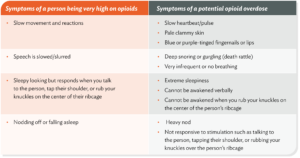In June, two Ohio State University students died after taking what they believed to be Adderall, a prescription stimulant that is frequently misused by college students, but was actually the synthetic opioid fentanyl. The students were not alone. Accidental fentanyl overdoses occur far beyond campus walls, impacting thousands of individuals, families and communities across the United States.
In 2021, deaths related to synthetic opioids, including fentanyl, reached an all-time high after rising 23% compared to the previous year. The Centers for Disease Control and Prevention (CDC) reports most fentanyl-related overdoses have been linked to illegally manufactured fentanyl that is mixed with other drugs like heroin or cocaine – with or without the end user’s knowledge.
As accidental fentanyl deaths continue to increase, it is important to learn about the many resources that exist to combat this issue, as well as ways you can help with Mental Health First Aid (MHFA).
MHFA training teaches you how to recognize and respond to signs and symptoms that may indicate someone is experiencing an opioid overdose. It’s important to recognize the differences between someone who is very high on opioids and someone who may be experiencing an overdose. (See chart.) Differentiating between the two can you know when it is appropriate to call 911 and/or administer naloxone.

According to the National Institute on Drug Abuse, fentanyl is 50 to 100 times more powerful than morphine. In fact, fentanyl and its illicit derivatives, or analogs, are so powerful that even a fatal dose may be invisible to the human eye. Fentanyl test strips (FTS) are a form of drug test that have been shown effective in detecting traces of fentanyl and fentanyl analogs in drug samples. The strips typically give results within 5 minutes and can be obtained online. If you or anyone you know is using or plans to use opioids like cocaine or heroin, it’s a good idea to test them before ingestion.
The MHFA manual provides information about naloxone, also known under the brand names Narcan and Evzio, an FDA-approved medicine that rapidly reverses an opioid overdose. This can serve as a temporary solution while awaiting a medical professional. Naloxone can be administered through a nasal spray, through an IV into the muscle or by needle underneath the skin. Knowing when and how to administer naloxone could help save a life by allowing more time for medical professionals to get to the site. Naloxone is available in all 50 states. While Narcan is designed not to require specialized training, there are training courses available to help recognize the signs of an opioid overdose and administer Naloxone, such as The Layperson Naloxone (NARCAN) training course.
Whenever an opioid overdose is suspected, check for breathing and pulse, administer naloxone if it is available and call 911 immediately. All you have to say is, “Someone is unresponsive and not breathing,” and provide an address. Stay with the person until medical help arrives! You may need to administer a second dose of naloxone if they’re not responsive.
As the number of fentanyl overdoses continues to rise, it is crucial to educate ourselves on the available resources such as naloxone, FTS and awareness and education programs like MHFA.
If you haven’t been trained in MHFA yet, take a course today! Certified First Aiders who want to get more involved, consider becoming a Certified Mental Health First Aid Instructor to help #BeTheDifference in your community and beyond.
References
American Addiction Centers. (2022, July 5). Adderall abuse among college students. American Addiction Centers. https://americanaddictioncenters.org/adderall/adderall-abuse-among-college-students.
Breen, Kerry. (2022, May 19). Overdose deaths hit all-time high in 2021. Why some drug policy experts still have hope. Today. https://www.today.com/health/health/drug-policy-experts-harm-reduction-overdoses-rise-rcna28296.
Bruner, Bethany. (2022, June 28). Autopsy reports confirm two Ohio State students died of accidental fentanyl overdoses. The Columbus Dispatch. https://www.dispatch.com/story/news/local/2022/06/28/autopsy-reports-confirm-ohio-state-students-died-fentanyl-overdoses/7759211001/.
California Department of Public Health. (n.d.). Fentanyl testing to prevent overdose. https://www.cdph.ca.gov/Programs/CID/DOA/CDPH%20Document%20Library/Fact_Sheet_
Fentanyl_Testing_Approved_ADA.pdf.
Centers for Disease Control and Prevention (CDC). (2022, June 1). Fentanyl. https://www.cdc.gov/opioids/basics/fentanyl.html.
CDC. (2022, May 11). U.S. overdose Deaths in 2021 increased half as much as in 2020 – but are still up 15%. https://www.cdc.gov/nchs/pressroom/nchs_press_releases/2022/202205.htm.
DanceSafe. (2022, June 11). Fentanyl test strips – box of 100. https://dancesafe.org/product/fentanyl-test-strips-box-of-100/.
National Institute on Drug Abuse. (2021). Fentanyl DrugFacts. National Institutes of Health. https://www.drugabuse.gov/publications/drugfacts/fentanyl.
Substance Abuse and Mental Health Services Administration (SAMHSA). (2018). Opioid overdose prevention toolkit. https://store.samhsa.gov/sites/default/files/d7/priv/sma18-4742.pdf.
Substance Abuse and Mental Health Services Administration (SAMHSA). (2022, April 21). Naloxone. https://www.samhsa.gov/medication-assisted-treatment/medications-counseling-related-conditions/naloxone.